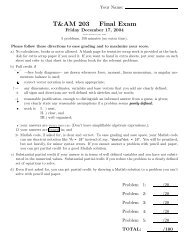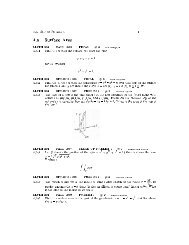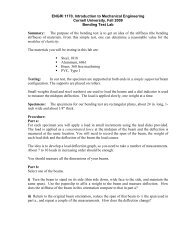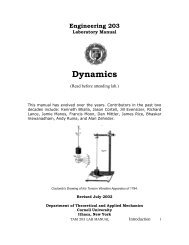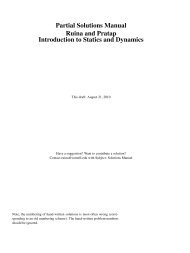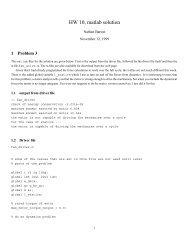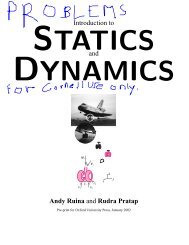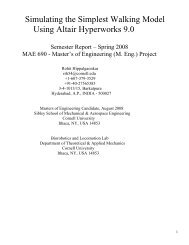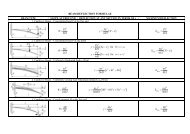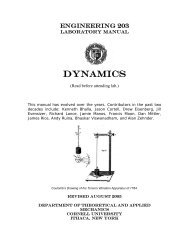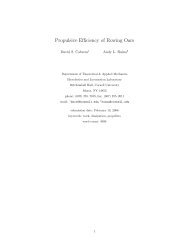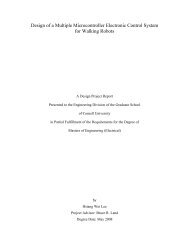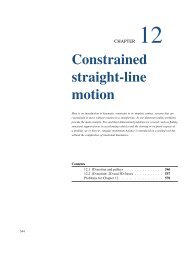Introduction to and Andy Ruina and Rudra Pratap
Introduction to and Andy Ruina and Rudra Pratap
Introduction to and Andy Ruina and Rudra Pratap
You also want an ePaper? Increase the reach of your titles
YUMPU automatically turns print PDFs into web optimized ePapers that Google loves.
18 Chapter 0. Preface 0.2. A note on computation<br />
We do know that you need <strong>to</strong> think outside of the confines of your usual<br />
study resources. Like when you are relaxed, away from the pressures of<br />
books, notes, pencils or paper, say when you are walking, showering or lying<br />
down. These are the places where you naturally work out life problems, but<br />
they are good places <strong>to</strong> work out mechanics problems <strong>to</strong>o.<br />
Having an animated mechanics discussion with friends is also good. You<br />
should enjoy your inner nerd socially. Are your friends turned off by techtalk<br />
There are billions of people out there, you should be able <strong>to</strong> find one or<br />
two that like <strong>to</strong> talk shop.<br />
0.2 A note on computation<br />
Mechanics is a physical subject. The concepts in mechanics do not depend<br />
on computers. But mechanics is also a quantitative subject; relevant amounts<br />
(of length, mass, force, moment, time, etc) are described with numbers, <strong>and</strong><br />
relations are described using equations <strong>and</strong> formulas. Computers are very<br />
good with numbers <strong>and</strong> formulas. Thus the modern practice of engineering<br />
mechanics uses computers. The most-needed computer skills for mechanics<br />
are:<br />
solution of simultaneous linear algebraic equations,<br />
plotting, <strong>and</strong><br />
numerical solution of ODEs (Ordinary Differential Equations).<br />
More basically, an engineer also needs the ability <strong>to</strong> routinely evaluate st<strong>and</strong>ard<br />
functions (x 3 , cos 1 , etc.), <strong>to</strong> enter <strong>and</strong> manipulate lists <strong>and</strong> arrays of<br />
numbers, <strong>and</strong> <strong>to</strong> write short programs.<br />
Classical languages, applied packages, <strong>and</strong> simula<strong>to</strong>rs<br />
Programming in st<strong>and</strong>ard languages such as Fortran, Basic, Pascal, C++, or<br />
Java probably take <strong>to</strong>o much time <strong>to</strong> use in solving simple mechanics problems.<br />
Thus an engineer needs <strong>to</strong> learn <strong>to</strong> use one or another widely available<br />
computational package (e.g., MATLAB, O-MATRIX, SCI-LAB, OC-<br />
TAVE, MAPLE, MATHEMATICA, MATHCAD, TKSOLVER, LABVIEW,<br />
etc). We assume that students have learned, or are learning such a package.<br />
Although none of the homework here depends on such, we also encourage<br />
you <strong>to</strong> play with packaged mechanics simula<strong>to</strong>rs (e.g., INVENTOR,<br />
WORKING MODEL, ADAMS, DADS, ODE, etc) for testing <strong>and</strong> building<br />
your intuition.<br />
How we explain computation in this book.<br />
Solving a mechanics problem involves<br />
1. Reducing a physical problem <strong>to</strong> a well posed mathematical problem;<br />
2. Solving the math problem using some combination of pencil <strong>and</strong> paper<br />
<strong>and</strong> numerical computation; <strong>and</strong>



